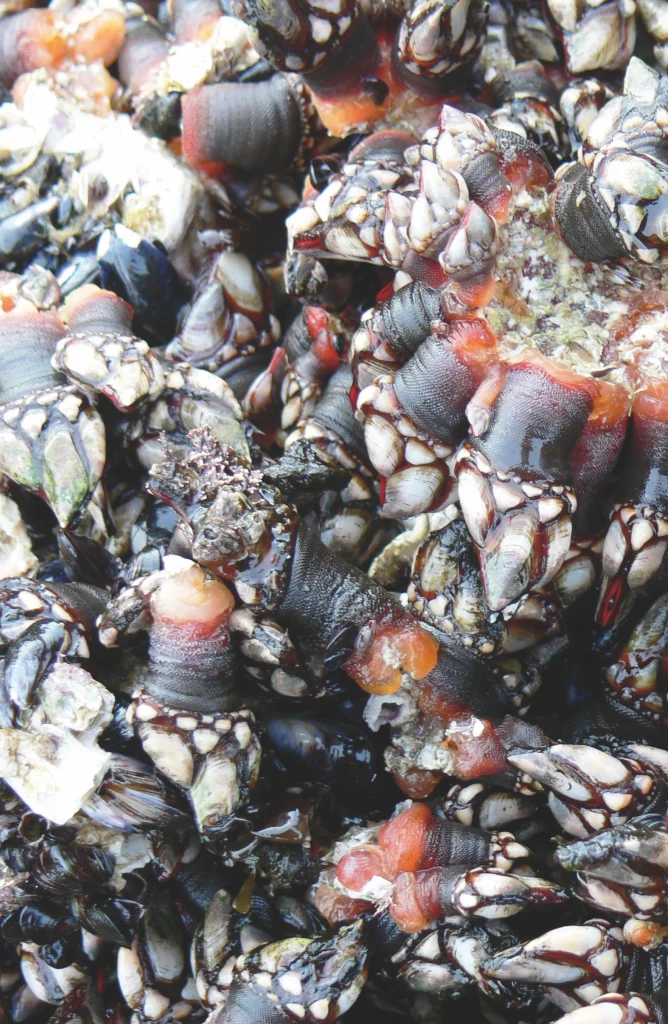
Cuisine is now one of the major tourist attractions for any region, along with its natural and historical heritage. Caring for this resource is an essential factor when planning a tourist destination.
Cookery programmes are becoming more and more common on the TV and radio, while articles in newspapers and magazines are sparking travellers’ interest in the subject.
The value of a cuisine in a region like the Costa da Morte depends on several factors. The essential ones include the raw materials that are available, meaning the products and ingredients necessary to prepare local dishes, the gastronomic culture forged over time by the region’s inhabitants and the academic training of the staff who work in restaurants that offer locally made dishes.
Cuisine or the art of cooking, in the widest sense of the word, is an integral part of the interests of any modern society that enjoys a certain level of well-being. The demand for well made dishes used to be a phenomenon limited to privileged sectors of society: nobles, hidalgos and the bourgeoisie, since the lower classes, who lived mostly in the country, concerned themselves more with growing enough food to eat and keep hunger at bay.
If one bears in mind that most of the population of the Costa da Morte lived and still lives in small villages, with the exception of those who live in the coastal towns, it is easy to understand why regional cuisine was very underdeveloped, as was the case in the rest of rural Galicia. Pork was the basis of the inland diet, complemented with other products that the farmer obtained with his work, such as milk, eggs, some vegetables, greens and fruit. The diet in coastal areas revolved more around products from the sea: sardines, horse mackerel, octopus and other species, but pork was also consumed.
Strangely enough, the shellfish and many types of fish that now form a part of the delicious cuisine of the Costa da Morte were hardly appreciated by poorer families.

Barnacles, which are now regarded as the king of seafood, were not popular with coastal families and were only eaten if there was nothing else available, as with other types of shellfish that are now greatly appreciated in today’s cuisine. Even now, some elderly locals from the coast say that a plate of barnacles and potatoes is poor people’s food.
Shellfish and many types of fish began to acquire more cachet in the nineteen sixties and seventies, when families’ purchasing power increased and the demand for such products steadily grew, especially at certain time of the year, such as Christmas, Holy Week and in the summer.
The cuisine of the Costa da Morte took on more importance at the end of the 20th and the early 21st centuries, when tourism became one of the main resources of the region. The spending power of the visitors increased demand for services in the hospitality sector and for regional dishes such as fish and shellfish.
The opening of new restaurants has contributed to an evolution in traditional cooking and an increased demand for more qualified staff who can prepare more creative and varied dishes, and create a more modern cuisine, without losing essential traditions and using the excellent local raw materials as a basis.
Few regions in Galicia can offer such a wide range of natural products of such high quality as does the Costa da Morte. All types of fish and shellfish are caught along its coast, while further inland excellent greens and vegetables are produced, along with some truly exceptional meats, which, taken together. provide the best in raw material for the delicious dishes of the region. The fact that the region produces the very best from both sea and land means that local cuisine offers a very representative sample of Galician cuisine, since here there are almost all the ingredients that can be found in other parts of the community.
The most popular dishes at local restaurants are without a shadow of a doubt ones made with products from the sea. The extraordinary quality and relatively affordable price of such dishes tempts many visitors to ask for seafood menus.
The region offers all types of shellfish, with the exception of oysters and scallops, which come from the Rias Baixas, . The most popular of these for many diners is barnacles, a type of shellfish that is very abundant on the local coastline and of truly exceptional quality.
The prices charged for barnacles on the market at certain times of the year is easy to understand when you consider just how dangerous it is to extract them from the rocks. They are very easy to prepare, just a brief spell in boiling salt water or seawater and they are ready to eat. A festival of appreciation of this very popular shellfish is held very July in the town of Corme.
But if the barnacle is regarded as the king of shellfish on this coast, velvet crab, spider crab, edible crab, spiny lobster, clawed lobster and king prawns were very abundant on this coast, although now their numbers have been reduced. The traditional way to prepare this type of shellfish requires no special recipe, they were simply boiled for a while in water with salt. Some shellfish, like the spiny lobster and the edible crab, are prepared with a vinaigrette. Modern cuisine now has other ways of preparing shellfish. Spiny lobster and clawed lobster can be prepared grilled, while clawed lobster can be made with rice, which is one of the most popular dishes for this type of shellfish.
Shellfish such as cockles, clams and razor-shells are also very common in the rias of Corcubión, Camariñas and Laxe.
Cockles, are best eaten raw, as Alvaro Cunqueiro once said, to really appreciate the natural flavour of the sea. But they are also very tasty when steamed, cooked with rice or baked in a pie. Clams, like in many other parts of Galicia, are prepared in a wine and parsley sauce, but they are also delicious steamed, grilled, cooked with octopus, with beans or with fine noodles.
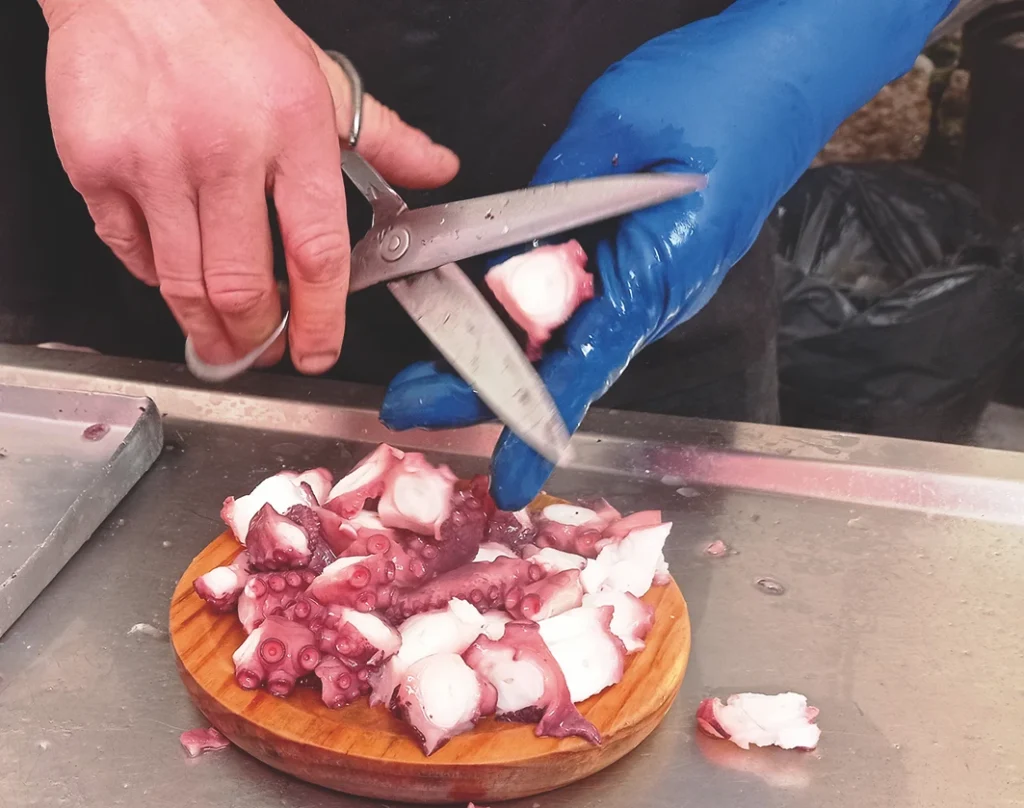
Longueiróns and navajas (two types of razor-shells) are another very popular type of shellfish. They are almost identical. The navaja has a slightly shorter and more curved shell than the longueirón. They are often served grilled with a few drops of olive oil, but they can also be prepared in pies. The Festa do Longueirón is held every August in the town of Fisterra.
Octopus is one of the most appreciated species on the coast. The most traditional way to prepare it is á feira, when it is boiled and served on wooden plates with salt, olive oil and smoked paprika. Recent years have seen the introduction of many other ways of preparing octopus: grilled, in pies, with clams, etc.
Another cephalopod that is widely appreciated in the local cuisine is squid, especially when it has been jig-caught. A delicious way to prepare it is with its own ink with rice, although it can also be fried or cooked with onions.
There is such a wide variety of fish that it is difficult to list all the species that are caught and prepared here: flounder, sole, grouper, hake, sea bream, horse mackerel, sea bass, conger eel, wrasse, sardines, mackerel and yellowtail are some of the best known species. The “caldeirada”, (fish stew) is a dish invented by sailors, and is one common way of preparing fish in this region. Grouper, ray, hake, conger, red scorpionfish, wrasse, brown wrasse and horse mackerel are the species most commonly used for this dish. Besides using good quality fish, another secret is to salt it a few hours before cooking, and make a good garlic sauce. Excellent caldeiradas can be found at any of the region’s fishing ports. Flat fish, flounder or sole, is best served grilled or barbecued.
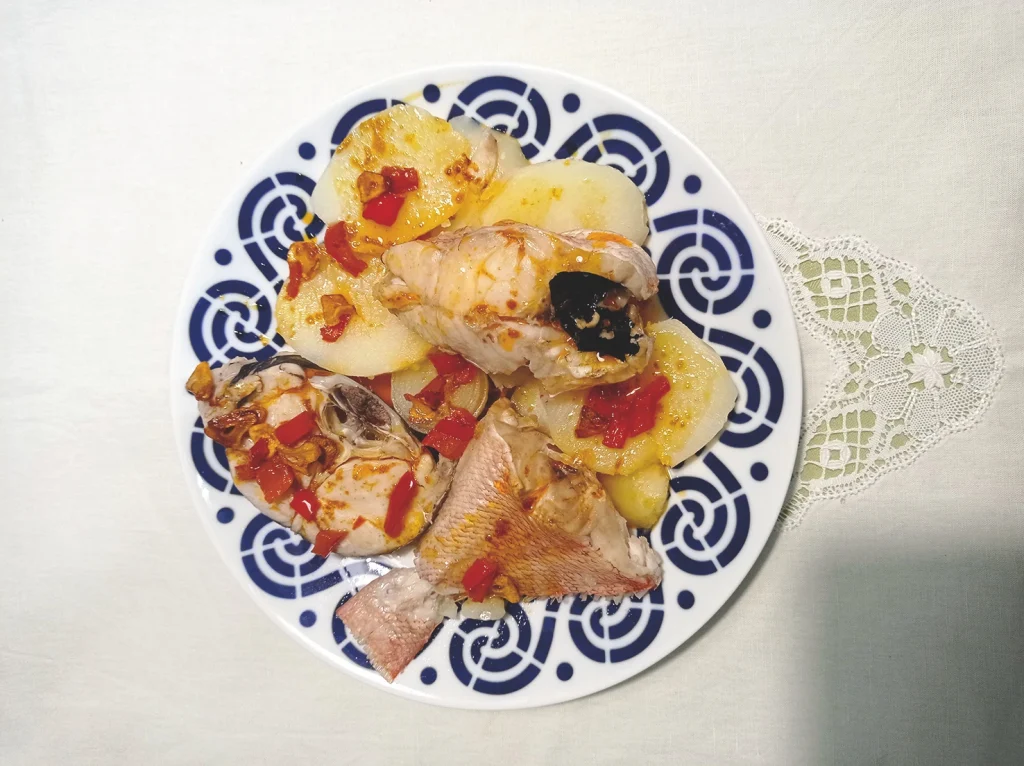
Other fish, like hake sea bass, sheepshead and other species can be grilled or barbecued and served boneless with boiled potatoes and a drizzle of olive oil.
One of the tastiest dishes to be found on the coast in summer are roast sardines. Visitors taking a walk through one of the local fishing villages will be sure notice the delicious aroma of roasting sardines. Some bars and restaurants in the port area offer this dish with some good bread and potatoes cooked in their skin: a real delight for the tastebuds. Many of the region’s traditional fiestas would not be complete without a big sardiñada (sardine roast).
Small sardines, or xoubas are fried, put in a caldeirada or in an “empanada” or pie. Empanadas in this region are made with cornflour pastry and are one of the most typical dishes to be found in the traditional local cuisine. Roast or grilled mackerel and horse mackerel are also delicious. Both may be humble but they are very tasty and nutritious. Smoked or fried mackerel are also well worth a try.
Other products of the sea have recently been making a big impact on regional kitchens, such as seaweed and sea urchins. Prepared as a pate or sauce, they give dishes a characteristic marine flavour.
Seaweed is abundant on the coast of the Costa da Morte. After being gathered and dried, it is sold to prepare a range of dishes. The culinary influences of countries like Japan, China and Korea and changes in eating habits have led to seaweed being included in the local cuisines, thanks to its low calorie content and high levels of fibre and minerals. There are many ways of preparing it according to the type of seaweed. It can be used to accompany or garnish different kinds of dishes: salads, sautéed vegetables, with rice, in soups and broths, etc.
While the dishes prepared with ingredients from the sea are the best examples of what the regional cuisine has to offer, the local meat, vegetables and greens are of the best quality and very abundant. Any restaurant will offer diners the chance to try exquisite meat-based dishes.
Thanks to the influence of local people who emigrated to South America, many restaurants offer meat grilled on a charcoal barbecue. A very popular dish is charcoal barbecued pork or veal tenderloin, and lamb or veal chops. The traditional dish of roast veal can still be seen on many menus, but demand for it has dropped in recent years. Other delicious meat dishes include free range chicken and lamb.
Stewed tripes are one of the most traditional dishes in regional fiestas and fairs. The Faguía is celebrated on the first day of the fiestas of San Cristovo de Carnés, and consists of a meal that was first held in the early 16th century after the foundation of the brotherhood of penitents of the parish and which now consists of handing out dishes of stewed tripes to all the attendants.
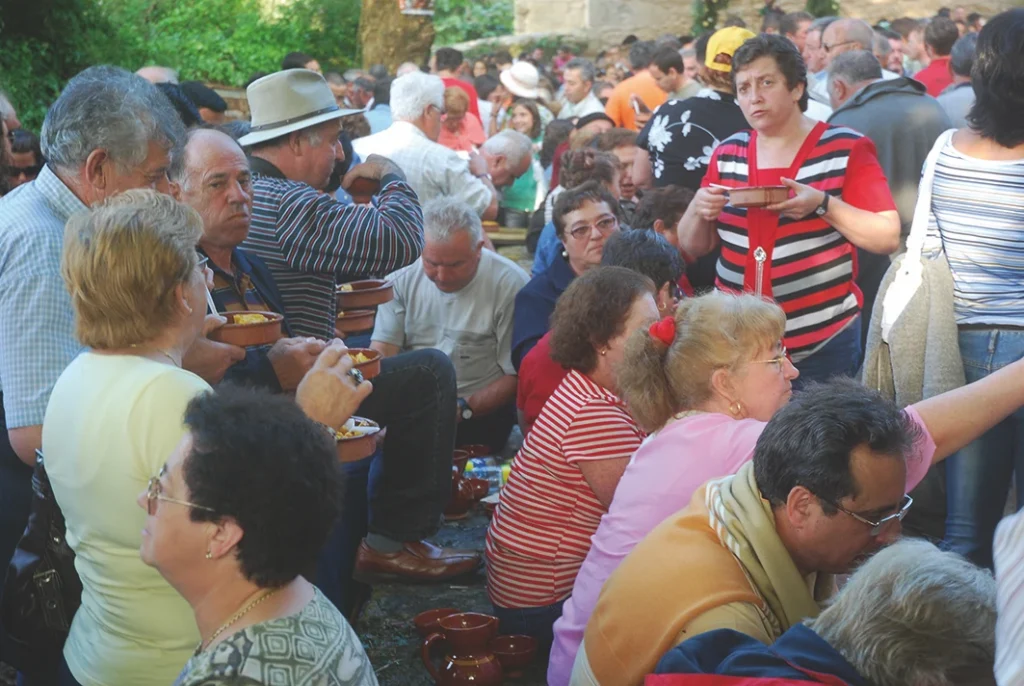
In winter, especially with the approach of the Carnival, restaurants offer the typical dishes cocido gallego (boiled pork, potatoes, chickpeas and greens) and lacón con grelos (pork hock and turnip greens); solid fare to beat the winter chill. There are eating houses and restaurants that specialise and offer group menus for these types of foods.
Restaurants in recent years have been adapting their dishes to the changes in eating habits that are taking place in modern society, characterised more than anything by a greater consumption of greens and vegetables.
The land in the regions of Bergantiños and Soneira have very good conditions for growing products such as these and offer a lot of potential for ecological farming, which is seeing a growing demand amongst consumers. The coastal valleys of the region have a tradition of producing good quality vegetables: these include Baldaio (Carballo), Barizo (Malpica), Traba (Laxe) and Merexo (Muxía), where a great deal of garlic and onions were grown and exported to other parts of Galicia and elsewhere. Other valleys of the interior also have good land for cultivating market garden crops that could supply nearby restaurants with local produce.
We have seen that restaurant menus include a growing number of cold and warm salads of all kinds, and greens such as turnip greens and collard greens to accompany many of their dishes.
The potatoes grown in the region are also of exceptional quality; both the indigenous variety of Carballo and other species that have adapted without problems to local conditions. Coristanco potatoes are rightly famous, and the Festa da Pataca, a major celebration of the potato is held there.
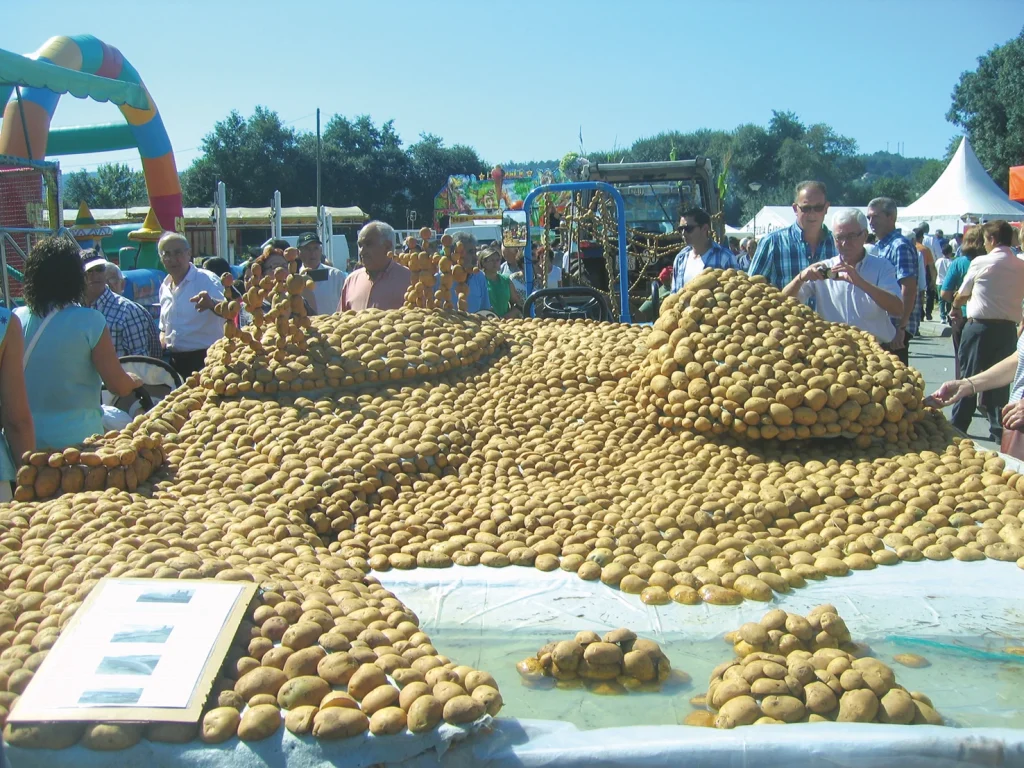
The beans of Bergantiños and the Terra de Soneira are very good quality and are sold at the fairs of Carballo, Baio and Ponteceso. The town hall of Ponteceso organises the Feira das Fabas (bean fair) in late October, and has been doing so since 1990.
Some market gardens also produce fruit, such as strawberries, cherries, apples, pears, figs and walnuts, which are used to prepare a range of dishes, especially desserts. Cherry trees are delicate and easily affected by atmospheric pollution, and production has dropped a lot in recent years, but the valley of O Anllóns once produced many cherries. The fairs held in season at Carballo and Paiosaco were when the fruit produced was sold. The Feira das Cereixas is held on the first Sunday of July in Paiosaco; a festival that commemorates the times when this fruit was abundant in the area.
Restaurants offer a wide range of desserts for customers to try and enjoy. Some are offered at certain times of the year, such as filloas (pancakes) and orejas (palmiers), which are an integral part of the Carnivals and combine very well with the traditional dishes of cocido and lacón con grelos. Others were a typical part of traditional fiestas, such as cheese with quince, rice pudding, brioche, sponge cake, chocolate roulade and many different types of tarts. However, many of the desserts seen on menus are made by the restaurants themselves. The wine lists also offer a wide range of wines, both local and from other wine-making areas, from which customers can select a wine to match the meal and their preferences.